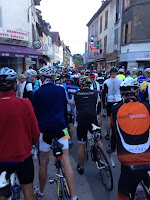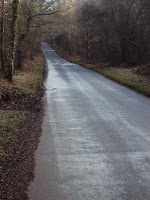 |
| Alpe d'Huez - profile |
As I reached the start of Alpe d’Huez I decided I had enough water to get to the top. I didn’t need food now so I missed the last feed. Crowds had gathered at the bottom and gave the passing cyclists a huge cheer. Shouts of “allez, allez”. It gives you a lift and at first I thought the legs felt good and getting carried away in the moment I “danced” on the pedals and picked up speed on the first ramp towards hairpin 21. Quickly I realised my legs were not nearly as fresh as I thought, I watched my heart rate shoot up and before I knew it I was in difficulty. I quickly sat back in my saddle and it dawned on me this was going to be a tough grind to the top. On the Thursday when I climbed Alpe d’Huez relatively fresh the first few miles seemed hard with its steep ramps averaging over 10% with sometimes pitching up to 13%. This is tough at any stage in a ride, but after 100 miles it almost became and ordeal.
 |
| Dutch Corner, Alpe d'Huez - Stage 19 2011 TDF |
The memory of climbing Alpe d'Huez with Chris and Tim in 2011 during the last week of the Tour de France seemed a long way from where I was now. We had gone up three times that holiday, going as fast as we could and also leisurely riding up during stage 19 which finished atop the Alpe, taking in the atmosphere, taking pictures and enjoying the sights and sounds. Now I was just in my own little world, which was mainly a world of pain. This mountain took on a totally new demeanour after 100 miles taking in some of the biggest cols used in the Tour. As the hairpins count backwards from 21 these almost became like a form of mental torture. Sections between some hairpins are longer than many climbs in England and they tick by at a painfully slow rate. I started to think “how am I going to get through this?” People at the side of the road continue to offer encouragement. In front of them are hundreds of cyclists labouring up this huge mountain. A stage of the Tour it isn’t, but the locals know their cycling, they know what you have been through, they know how hard La Marmotte is and they respect you for the pain and suffering you are going through.
 |
| Climbing the Alpe |
Sean Yates, an ex professional and now a directeur sportif at Team Sky, once said, "Alpe d'Huez maybe legendary, but it isn't actually that hard".
Well I must be on the wrong mountain. Each hairpin offers the briefest respite from the relentlessly steep gradient and it was an opportunity to drink some of the water that was getting ever warmer under the searingly hot sun. I get some further encouragement from more spectators and briefly surge forward to put on a bit of a show and they would reciprocate by cheering even louder. But soon enough the gradient kicks in and the speed quickly recedes as I aim for the next hairpin. Despite the amount of cyclists on the road the banter and chit chat of the Glandon and Telegraphe had long since disappeared. In fact that went 1km into the climb of the Galibier. Apart from the people lining the side of the road on parts of the climb everyone is silent, suffering in their personal purgatory. I'm surrounded by other cyclists but this is now a very lonely place, no one else can help me get to the top. It is my legs, my heart, my lungs and above all my head. The will to keep going, to believe this will be over at some point. It cannot go on for ever although with one, two, three, six hairpins in I wasn't so sure.
 |
| Bourg d'Oisan |
 |
| Fausto Coppi - Alpe d'Huez 1952 |
By hairpin 14 I had been climbing for 25 minutes, far longer than any hill in Kent. Down below is a spectacular view of Bourg d’Oisan but it barely registered, instead I looked up at what still laid ahead. It was not a pleasant sight. The lactic acid filled my legs, my thighs felt like they had been hollowed out and my body was now just aching from being in the saddle for almost seven and a half hours. My body was reaching its limit so it was down to my head to keep me going. It was a battle but if I gave in mentally I’d be walking up the Alpe rather than cycling. All the hours and miles of training back home were to cycle these iconic mountains and I was not going to stop on the most mythical of them all. From the legendary Fausto Coppi in 1952 to the great Colombian climber Luis Herrera, to the controversial Lance Armstrong and to the mercurial Marco Pantani, Alpe d’Huez has been the arena for some of the greatest battles and stage wins in professional cycling. Like securing a major in golf, or a grand slam event in tennis, if you secure a stage win on Alpe d’Huez your life as a professional cyclist changes for ever. Watching stage finishes on Alpe d’Huez is part why I love the sport of cycling and is the main reason why I was here.
Between hairpin and 11 and 10 I was just about halfway but again, like on the Galibier I looked up and I couldn't quite believe where I was headed. In front is just the sheer face of the mountain side and it is a wonder how they have cut a road into it. It is hard to take in, but again, there are points where I can look down to where I have been and see the line of cyclists making their way up the Alpe. Added to the steepness and length, the other problem with Alpe d’Huez is that when the sun is out there is barely any shade and very little breeze; you just cook on the side of the mountain. I like the heat, and I like cycling in the heat but past halfway I was willing the small clouds to cover the su n and give me some respite. At hairpin 7, “Dutch corner”, the event organisers had set up a water stop and it was sorely needed. I didn’t want to get off as I just wanted to keep my rhythm going. I took one cup off one of the volunteers on the move and threw it over my head. The next volunteer slightly further up the road didn’t even wait for me to take the cup off him, he just chucked the water in my face. It was cold and initially a shock but after a few pedal strokes it was relief just to have the cold water dripping down my head and back.
 |
| View nearing the summit |
The relief didn’t last and before long I was cooking back in the Alpe d’Huez oven as I was before Dutch Corner. After hairpin 5 I knew I was much nearer the top than the bottom. An hour of climbing had passed and my altimeter was reading 1450m. I did the maths in my head, the climb started at 750m; it finishes at 1850m, so 700m done, 400m to go. It all helps. A local climb I regularly ride in Kent, Toys Hill, rises 100m in altitude so I started to use this as way to mentally tackle the last few miles to the top. 400m of vertical climbing, that is four Toys Hills. 300m, that is three and so on. Problem is when I cycle Toys Hill I never feel quite as bad as I was feeling on the Alpe. Even though I was inside the last 25% of the climb, stretches between hairpins can be so long, so much so that I just looked down and let them come to me rather than looking ahead to the corner which seems like it isn’t getting any closer. But the finish was near.



























